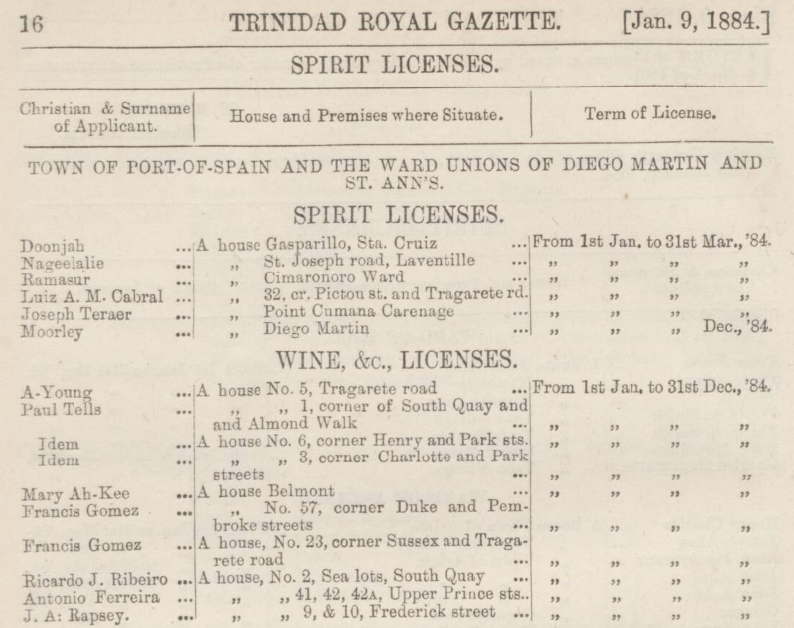This week at The Archive we are delighted to welcome a trio of brand new titles: namely the Trinidad Royal Gazette, the Telford Journal and the Dudley & District Chronicle, as we have added an incredible 840,335 brand new pages to our collection. Meanwhile, we have updated 32 of our existing titles from across Scotland and England.
So read on to learn more about our new and updated titles of the week, and also to discover more about Trinidad and Tobago’s most wanted, as we explore the pages of the Trinidad Royal Gazette to uncover the ‘particulars of offenders at large.’
Register now and explore the Archive
It’s only fitting then that we begin our survey of our trio of new titles this week with the Trinidad Royal Gazette. Established in 1835, the Trinidad Royal Gazette’s purpose was to publish official government information regarding the islands of Trinidad and Tobago.
During this time, the islands of Trinidad and Tobago, alongside other smaller surrounding islands, fell under British colonial rule. Trinidad had been surrendered to the British from Spain in 1797, having been colonised by the Spanish following Christopher Columbus’s arrival in 1498. Its sister island, meanwhile, Tobago, had been ruled variously by the British, Spanish, French, and Dutch before 1802. Trinidad and Tobago were unified in 1889.
The country, the most southern island country in the Caribbean, had an incredibly diverse population. After Trinidad’s incredibly cruel first British governor, Thomas Picton, was recalled, families from Britain, Ireland, Germany and Italy emigrated to the island. Trinidad and Tobago were also home to a large enslaved population. After emancipation, indentured workers from India, China and Portugal were brought to the islands, and were paid meagre wages.
The Trinidad Royal Gazette, then, contained notices essential to the governance of Trinidad and Tobago, which often had to be published as a legal requirement. These notices included the announcement of new laws, notices of amendments to laws, government appointments, tender notices and announcements of successful contracts.
The Trinidad Royal Gazette also included incredibly detailed police notices, with information ‘of offenders at large,’ with full physical descriptions. The paper also printed the names and addresses of those with spirit or wine licenses, and so the title can be a useful tool in tracing those ancestors who either broke the law or who were licensees in Trinidad and Tobago in the 1880s and 1890s. Furthermore, the Trinidad Royal Gazette also printed a summary of those criminal cases tried before magistrates, notices of bankruptcy and hospital dues.
This series of the Trinidad Royal Gazette ran until 1962, when Trinidad and Tobago gained its independence from Britain. Its second series, the Trinidad and Tobago Gazette, runs until this day. Trinidad and Tobago became a republic in 1976.
Our next new title this week is the Dudley & District Chronicle. Part of the Chronicle series of newspapers, with sister papers including the Sandwell Chronicle, the Dudley & District Chronicle is a weekly edition of popular West Midlands evening title the Wolverhampton Express and Star, which was founded in 1874 and is known today as simply the Express & Star.
The Dudley & District Chronicle, then, covers the news from the market town of Dudley, in the West Midlands, which is historically a part of Worcestershire.
The final of our trio of new titles is Shropshire’s Telford Journal. Serving Telford, a new town which was designated on 13 January 1963 and developed into the 1970s, the Telford Journal appeared on a weekly basis.
At one time the ‘most read title in the area,’ during the 1980s it had an impressive distribution of some 50,000 copies. However, the title, like other newspapers, struggled during the pandemic, temporarily ceasing publication.
That’s it from our new titles of the week, but we have a bumper crop of updates to our existing titles for you to enjoy. Leading the charge, and continuing with our Shropshire theme, is the Shropshire Star, to which we have added over 50,000 brand new pages. Also with significant updates are the Milton Keynes Citizen and the Buckingham Advertiser and Free Press, to which we have both added over 25,000 brand new pages.
We’ve also updated eight of our Scottish newspaper titles. We’ve added a new year to evangelical title Witness (Edinburgh), whilst we’ve also added years to the likes of the Fife Herald, the Kilsyth Chronicle and the Carluke and Lanark Gazette.
The Trinidad Royal Gazette and ‘Particulars of Offenders at Large’
One of the most intriguing elements we found whilst exploring the Trinidad Royal Gazette were the ‘particulars of offenders at large.’ These were notices which gave information about those charged with crimes who were yet to be taken up by police, and were issued by the Police Head Quarters at the Port of Spain.
What makes these particulars, as printed by the Trinidad Royal Gazette, so compelling is the level of detail they provided, whilst also revealing the diverse nature of the islands of Trinidad and Tobago during the 1880s and 1890s.
For example, let’s take the particulars of Henry Ashcroft, which were printed by the Trinidad Royal Gazette on 26 July 1894. Henry Ashcroft was wanted on the charge of ’embezzlement of $24 at Port-of-Spain on the 22nd day of January, 1894,’ in a notice issued by Inspector General of the Police, E. Fortescue.
As was typical of these notices, the wanted person’s name, age, height, race and profession were all listed. We learn, therefore, that Henry Ashcroft was about 30, 5 feet 8 or 9 inches, white, from England and was working as a tailor. There are also some additional remarks which help us to build up a fuller picture of Henry:
Ordinarily built, full moustache, and wears a pair of black Spectacles.
Let’s take a look at a few more examples. On 28 December 1887 the Trinidad Royal Gazette printed several ‘particulars of offenders at large,’ this time issued by Captain A.W. Baker, Inspector Commandant of Police, from the Police Barracks in Port of Spain. Here we find examples of alleged crimes committed by people from a range of different backgrounds.
Amongst them is 27-year-old Joseph Thomas, alias Bajan, a boatman from Barbados who was wanted for ‘wounding at Port-of-Spain.’ The notice in the Trinidad Royal Gazette goes into great detail about his appearance, noting how he has a ‘small scar over left eye, two small scars on forehead, short nose, small mouth.’
Then there was 35-year-old Mohon, alias Mochoon, a labourer originally from Calcutta (Kolkata). He was wanted for ‘escaping the convict depot at Chaguanas on the 6th day of Decr., 1887.’ He is described as having ‘small pox marks on face, several scars on feet, wears whiskers and beard.’
Alongside him, from the same 28 December 1887 notices, was James Adams, alias ‘Doctor.’ Adams, who was 26, a carter and from St. Vincent, was wanted for ‘cutting and wounding at Port-of-Spain.’ The remarks are sparser on Adams, who is described as having a ‘scar on face’ and being of a ‘stout build.’
Lots of the ‘particulars’ covered those who had deserted from either the army or navy. One such deserter was 22-year-old John William Coward, of Preston, Lancashire, whose details were reported by the Royal Trinidad Gazette on 9 November 1887. Coward was wanted for deserting the Medical Staff Corps at St. James, Trinidad, on 16 October 1887. He was described as having a fair complexion, with ‘light brown hair, grey eyes.’
John William Coward was certainly not alone in his desertion, and it was not only British servicemen who deserted at Trinidad and Tobago. For example, on 13 January 1886 the Trinidad Royal Gazette published the details of 21-year-old Joseph Ludwig Landers, a sailor from Germany, who had deserted ‘from the Man-of-War ‘Stein’ at Port-of-Spain, on the 5th day of January, 1886.’ Joseph Ludwig Landers, who had ‘lost all the teeth in front,’ and had ‘brown hair, brown eyes,’ was able to speak both English and French. A ‘£2 reward [was] offered for his arrest,’ which was also the amount offered for the arrest of his fellow countryman and deserter August Bisson, a 19-year-old with tattoos on ‘both arms and breast.’
The Trinidad Royal Gazette did keep up with those charged with offences. For example, the surrender of deserter John William Coward was reported by the paper on 28 December 1887.
Delve into the Trinidad Royal Gazette to discover more about these ‘offenders,’ the history of Trinidad and Tobago, and more, as part of our collection of over 86 million newspaper pages.
New Titles
| Title | Years Added |
| Dudley & District Chronicle | 1989, 1995-1996 |
| Telford Journal | 1986-1991, 1993-1997, 1999-2000 |
| Trinidad Royal Gazette | 1884-1897 |
Updated Titles
This week we have updated 32 of our existing titles.
You can learn more about each of the titles we add to every week by clicking on their names. On each paper’s title page, you can read a free sample issue, learn more about our current holdings, and our plans for digitisation.
You can keep up to date with all the latest additions by visiting the recently added page. You can even look ahead to see what we’re going to add tomorrow.















